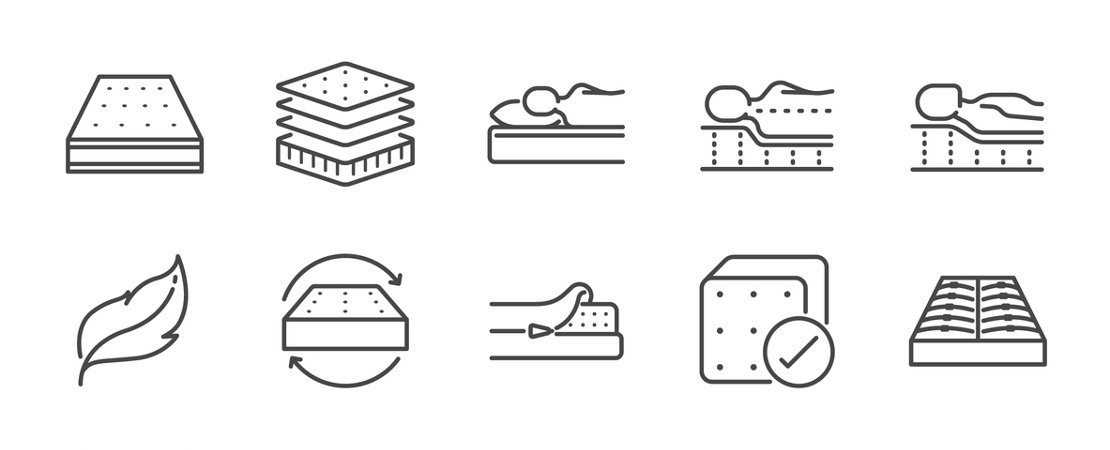Not sure where to start?
Answer a few simple questions and we’ll direct you to your perfect bed.
Enable notifications to get the best news on sales and special offers
Memory foam: beyond the hype
Have you heard of memory foam? If you have been looking for a new mattress, there is a good chance that you have. It is quite a popular term, usually employed to make a sale: “This one is better. It is a memory foam mattress.” Additionally, the salesperson would point out the superior comfort and support you can expect from such a mattress.
If you are a tad cynical about such claims, like I am, you will need proof. There was only one way to properly test these claims, and that was via personal experience. As a result, I spent four nights on a memory foam mattress. But, before I share my thoughts on the experience, let’s quickly get some terminology out of the way.

As the term implies, memory foam “remembers”, or retains, a shape that is pushed into it. It returns to its original shape quite slowly. In its structure, one can see a network of tiny bubbles. Under pressure, the air is pushed out of these bubbles. When pressure is removed, the air is slowly sucked in again and the memory foam returns to its original shape in some time.
Latex foam, however, does exactly the opposite. It has a mighty “bounce”, returning to its original shape immediately.
Memory foam’s density will determine its durability (and cost). High-density memory foam can also handle more weight. Scientists are constantly experimenting and coming up with new and improved versions of memory foam.
If you encounter the phrase “memory foam mattress”, keep the following in mind: it does not necessarily mean that the entire mattress is made of memory foam. It means that memory foam has been incorporated into the mattress design in some way. In almost all cases, memory foam is used as a top layer. With some bed designs, it is obvious, with a memory foam top layer proudly displayed. Additionally, you can get a thin “top layer” of memory foam separately, thereby customizing your bed to your comfort level.
When setting up the test, I specifically wanted to try a mattress with a thick slab of memory foam on top. I wanted the full effect of memory foam, without other materials muddying the waters. Moreover, I decided to keep to my normal sleeping routine. That way I didn’t subject the mattress to all kinds of strange tests I wouldn’t normally perform.

Lying down on the memory foam mattress for the first time was quite an experience. For maximum effect, I flopped down on my back, sinking slowly. I could feel the slow compression of the foam as it moulded around my physique. One thing I noticed immediately was the gentle back support. It was “there”, but subtly, without drawing attention to itself.
After a few minutes, I wanted to assume my favourite sleep position – on my left side. It took a few moments for the memory foam to mould itself to my body in the new position. Once that happened, it felt like I was floating again – the pressure from the mattress was close to zero. I woke up less often because I could sleep in one position for longer.
I tried to sleep on my stomach, but that didn’t last long. The memory foam seems to be on the soft side. As a result, my feet and head were too high and my spine was bending the wrong way. This didn’t come as a surprise, as most stomach sleepers prefer firm mattresses.
Many manufacturers claim that their mattresses minimise movement transfer, but few of them succeed. I have a busy sleeping partner who changes sleeping positions often. Small disturbances usually still get through, which tend to wake me up. The memory foam mattress’s motion transfer inhibition was amazing. Indeed, I couldn’t feel my sleeping partner’s movements at all!

One of the drawbacks of memory foam has to do with temperature. When asleep, our body temperature decreases by about one degree Celcius. Because of its chemical composition and structure, memory foam tends to absorb and retain heat. It also reduces breathability, which means that the trapped heat has less opportunity to escape. This can be a problem if you’re temperature-sensitive. Simply put, it may keep you awake.
There have been recent developments to address this issue, in the form of open-cell foam structures and gel bead -infused foam. Additionally, there are also practical ways to deal with this yourself.
I suspect that my sample mattress contained some improved version of memory foam. It seemed to absorb less heat than expected. It was only noticeable when I was trying to fall asleep. Despite that, it was comfortable enough to fall asleep anyway.
Some people complain about a slight chemical smell coming from memory foam. I did pick up a bit of an industrial/chemical smell the first night I slept on it. The thing is, the smell was similar to any new foam product, like a new sofa, for example. By the second night, I didn’t notice it any more, as it had tapered off significantly.
One of memory foams’ big plus points is that it is hypoallergenic. It also reduces dust mite infestation, as there is nowhere for the horrible little creatures to hide. Thankfully, I am not prone to allergic reactions, but it was an assuring fact to take note of.

I am impressed! I woke up feeling well-rested, without any back- or neck pain. A good mattress should preserve and support the natural curves of the spine, and this memory foam mattress did so excellently. The gentle nature of this support is particularly impressive.
The sheer comfort of the memory foam was also remarkable. The soft, luxurious feel is excellently balanced with firmness. I am a fan of firm mattresses, but after spending a few nights on this memory foam mattress, I might reconsider my preferred sleeping surface!
If anything, I would go for a thinner layer of memory foam. Sinking so deep into the mattress isn’t quite my thing. The gentle hugging becomes a bit restrictive after a while. In the end, it is something that boils down to personal tastes. In fact, it may just be exactly what you prefer in a mattress.
Do you want to try a memory foam mattress? We have various options available. Our sales staff will assist you in finding one to suit your taste and budget.
Double Bed Mattresses That Fit Your Budget
Guarding Your Home: What Are Effective Strategies for Bed Bug Defence?
The Importance of Mattress Hygiene and What To Look Out For
Crafting a Home Away from Home: The University Student’s Guide
Blackouts and Sweet Dreams: How the Right Mattress Defies Load Shedding
How to Choose the Best Baby Mattress
Bunk Beds: Maximise Space with Style
Love Your Health, Love Your Sleep
The Best Beds to Buy in 2024
Get the Best Black Friday Shopping Tips for 2023
Double Bed Mattresses That Fit Your Budget
Guarding Your Home: What Are Effective Strategies for Bed Bug Defence?
The Importance of Mattress Hygiene and What To Look Out For
Crafting a Home Away from Home: The University Student’s Guide
Blackouts and Sweet Dreams: How the Right Mattress Defies Load Shedding
How to Choose the Best Baby Mattress
Bunk Beds: Maximise Space with Style
Love Your Health, Love Your Sleep
The Best Beds to Buy in 2024
Get the Best Black Friday Shopping Tips for 2023